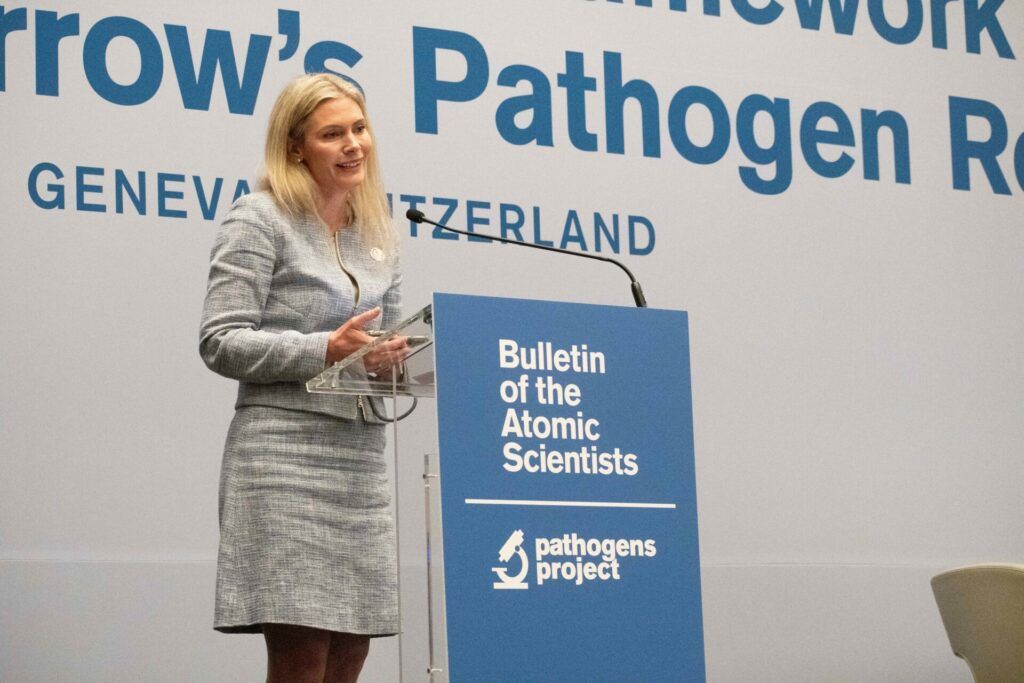How to avoid human-made pandemics
By Filippa Lentzos, Jens H. Kuhn | April 10, 2024
 Fillipa Lentzos, co-director of the Bulletin’s Pathogens Project task force, speaks at the 2023 conference Creating the Framework For Tomorrow’s Pathogen Research in Geneva, Switzerland.
Fillipa Lentzos, co-director of the Bulletin’s Pathogens Project task force, speaks at the 2023 conference Creating the Framework For Tomorrow’s Pathogen Research in Geneva, Switzerland.
How do you pitch a news story about people agreeing rigorously with each other?
That question was raised by a journalist during a report presentation at the UN by the Bulletin of the Atomic Scientists’ Independent Task Force on Research with Pandemic Risks. This 28-member task force, consisting of ourselves and other experts in biosafety, biosecurity, microbiology, epidemiology, and ethics from around the world, was taking questions about its new report, which tackles the highly challenging topic of recommending constructive ways to improve safety and security for research with known and potentially pandemic pathogens. The report was especially noteworthy because the diverse task force—some of whom publicly and vehemently disagree on which activities are risky and should be better monitored—was able to find common ground, and a lot of it.
As this one journalist stated, “journalists cover conflict.” This conflict orientation has been a consistent problem in news coverage of recent epidemics and pandemics and can, in our opinion, even be seen in a recent article in the Bulletin. Far too often, the stories of conflict have overtaken those of solutions. Science depends upon constructive conflict and that process is essential for learning lessons for the next pandemic. But if conflict becomes too polarized and personal it risks creating divisions that leave us less prepared for public health emergencies.
So let us look at where our group found consensus.
Most viral disease outbreaks stretching back over millennia have been caused by viruses transmitted to humans through direct or indirect contact with other animals. Our increasing encroachment on the natural environment and climate-driven changes in ecosystems are likely creating more opportunities (or even pressure) for potential pandemic viruses to spill over into novel animal hosts, including humans, now than in the past.
Studying viruses with spillover potential is the best way to combat them. At the same time, there is a growing awareness in the research community that field collection and experimental manipulation of such viruses—while sometimes scientifically crucial—carry risks of accidentally or intentionally seeding a pandemic after spreading to other workers, family members, and/or the wider community.
In general, current governance over occupational health and safety adequately weighs the direct biosafety risks to the researcher in the laboratory, and biosafety has gradually and significantly improved over time. But biosafety regulation is unevenly distributed across different countries, institutions, and facilities, and rapid advances in virology research are opening up new types of risk that still need to be incorporated into established biosafety frameworks (for example, future impacts of artificial intelligence on biological research). A small subset of research on known or potential pandemic pathogens requires consideration of how such research efforts—in or outside the laboratory—may accidentally, inadvertently, or intentionally disrupt the health of large groups of humans or other animals.
In 2022, the task force was convened by the Bulletin of the Atomic Scientists to analyze the trends and oversight of high-risk research on pathogens. The goal was to identify ways and means for research with pandemic risk to be managed as safely, securely, and responsibly as possible.
The task force’s report discusses the benefits and potential risks of virology research, including risks of unintentional exposure of researchers in the laboratory or field, or the local community, to biological agents, and risks of unauthorized access, loss, theft, misuse, diversion or release of biological agents, and it outlines emergent challenges in science and technology associated with pandemic pathogen research.
The report’s overriding recommendation is that when there is potential for harm to large numbers of people as a result of research with pandemic risk, and especially where it is questionable whether those at risk will benefit from the research, additional oversight, beyond occupational health and safety, is essential. Also crucial is a more elaborate risk assessment than is currently performed for research posing these risks.
Moreover, research with pandemic risk should have high-probability benefits for public health. Researchers and their institutions have an obligation to identify whether the risks from research with known and potential pandemic pathogens are proportionate to the potential benefits of the research and to assess whether less risky forms of research could be equally beneficial. In cases when there is not a proportionate harm-benefit ratio, researchers and their institutions have an ethical obligation not to perform that particular piece of research. Where the potential benefits of the research could be achieved by less risky means, the research design of choice should be the less risky one.
In other words, the bottom line for the task force is that research with pandemic risks should only proceed when the research community and relevant oversight bodies can demonstrate that the research would be conducted safely, securely, and responsibly; that no alternative and safer research could reach the same public-health ends; and that adequate assurances are provided of substantial benefits expected in the near term, with a plausible plan for equitable global distribution of these benefits.
Today, therapeutics and vaccines have reduced the disease burden of COVID-19, influenza, hepatitis C, poliomyelitis, and a variety of other viral diseases. Basic scientific knowledge obtained from studying viruses has been an essential foundation for creating lifesaving countermeasures. These countermeasures have greatly benefited public health and will continue to do so in the future.
Simply put, this important work saves lives. Yet, navigating research with pandemic risk warrants additional precautions. We must create, maintain, and continuously improve a safe, secure, and responsible work environment for researchers in the laboratory, the clinic, and the field. In so doing, and by starting from what unifies us rather than what divides us, there is a chance we can better manage the next pandemic and build public trust along the way.
Disclosures
This research was supported in part through the National Institutes of Health (NIH) National Institute of Allergy and Infectious Diseases (NIAID) prime contract with Laulima Government Solutions, LLC, (HHSN272201800013C). J.H.K. performed this work as an employee of Tunnell Government Services (TGS), a subcontractor of Laulima Government Solutions, LLC, under Contract No. HHSN272201800013C. The views and conclusions contained in this document are those of the authors and should not be interpreted as necessarily representing the official policies, either expressed or implied, of the US Department of Health and Human Services or of the institutions and companies affiliated with the authors, nor does mention of trade names, commercial products, or organizations imply endorsement by the US Government.
Together, we make the world safer.
The Bulletin elevates expert voices above the noise. But as an independent nonprofit organization, our operations depend on the support of readers like you. Help us continue to deliver quality journalism that holds leaders accountable. Your support of our work at any level is important. In return, we promise our coverage will be understandable, influential, vigilant, solution-oriented, and fair-minded. Together we can make a difference.
Keywords: biosafety laboratory, pandemic prevention, pathogens project, research risk assessment, task force
Topics: Biosecurity















